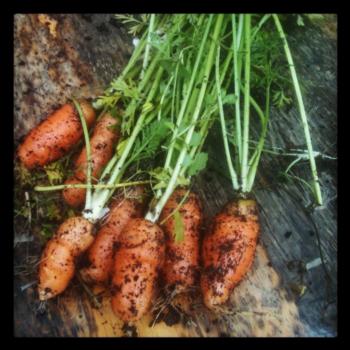Unused stories
Growing In Your Garden Now - Carrots

The Carrot Seed, Ruth Krauss’ 1945 classic story, reminds us there is much we can learn from children. Ruth’s story is about a little boy who plants a carrot seed and faithfully weeds, waters and tends it daily. When nothing comes up, Mother, Father and brother each say to him, “I’m afraid it won’t come up.” The big surprise, a sweet carrot as big as the boy’s wheelbarrow, reminds us that germination time varies greatly both by seed type and by soil temperature.
Members of the Apiaceae or parsley family, carrots are a cool weather crop. On an early summer ramble in the country, you have surely admired Queen Anne’s Lace, a wildflower kin to the carrot. Other vegetables in this family include parsnip, celery and fennel. Cultivated over two thousand years ago in Afghanistan, the first carrot was probably purple. You may notice that the top of a carrot exposed to sun may sport some of this ancestral purple color. The yellow carrot, a mutation, was most likely grown in the ninth century in Iran. Carrot cultivation spread from the Middle East to Europe by the fourteenth century. The first orange varieties were cultivated in Holland in the seventeenth century. North American settlers brought the orange carrot to the western part of the world.
The best time to plant carrot seed in Marin is from August to October. You can also plant it from February to March. Carrots grow best at a mean temperature of 65 degrees. Have you ever wondered where carrot seeds come from? Flower initiation in some plants begins only in the second year of growth after winter chill. This process is called vernalization; the promotion of flowering due to exposure to low temperatures or chilling.
To plant carrot seed, pick a sunny spot in a container, raised bed, row bed or border garden with sandy well drained soil. When planting any root crop, remember this old French proverb, Un binage vaut deux arrosages; One tilling of the soil is worth two waterings. Work and amend the soil with compost to twelve inches deep until friable; cloddy soil will not grow straight carrots and often produces forked carrots. Next, apply compost and mix it into the soil. If you add fertilizer, avoid excess nitrogen as carrots like a pH range of 5.5 to 7.0. When carrots get hairy, that is a sure sign of excess nitrogen. Rake ground level and irrigate until moist twelve inches deep. Plant the seeds about one-quarter inch deep with four seeds per inch. Cover the seeds with fine soil and water lightly once or twice a day until the seeds sprout. This may take as long as 21 days at soil temperatures of 55 to 80 degrees. Once sprouts appear, you can cut back on the watering, too much causes splitting. Thin the seedlings to three inches apart. Carrot seed tapes avoid a lot of backbreaking thinning; just apply a bit of flour and water on to a strip of newspaper and drop a small seed every three inches. Carrots are ready to harvest when they are large enough to eat anywhere from 60 to 90 days depending on the variety. Carrots left in the ground too long get woody.
The most successful carrot for Marin’s soil and climate conditions are the blunt end, smaller Nantes, Chantenay and Danvers varieties including ‘Royal Chantenay’, ‘Thumbelina Baby Ball’, ‘Nelson’ and ‘Yaya’. If you want to have some fun, try ‘Purple Sun’, wine-red to its core although like other purple vegetables, the color fades a bit when cooked. The best cultural practices are to work the soil well before planting, practice three year crop rotation, maintain even soil moisture and stay true just like Ruth Krauss’ young carrot growing hero!
By Anne-Marie Walker
